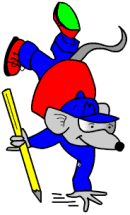This is another area of maths that children meet very early in their lives. Standard units of measurement (eg metres or kilos) are not taught at this stage – it would be pointless as many children are unable to count up to 100 or 1000.
Rather it is about comparing things – objects which are taller, wider, heavier, longer etc than other objects.
Get the vocabulary right at this age and they will have little problems with measurement later.
 Use these three free maths worksheets to encourage counting. As well as counting the number coloured you can ask other questions eg How many are not coloured? How many are coloured green? etc. Your child can also draw their own animals and colour them in different ways. Other questions you can ask are: How many legs are there? How many eyes? Can you draw three spots on each fish? etc. Remember to keep to very low numbers, just up to 5 to begin with.
Use these three free maths worksheets to encourage counting. As well as counting the number coloured you can ask other questions eg How many are not coloured? How many are coloured green? etc. Your child can also draw their own animals and colour them in different ways. Other questions you can ask are: How many legs are there? How many eyes? Can you draw three spots on each fish? etc. Remember to keep to very low numbers, just up to 5 to begin with.